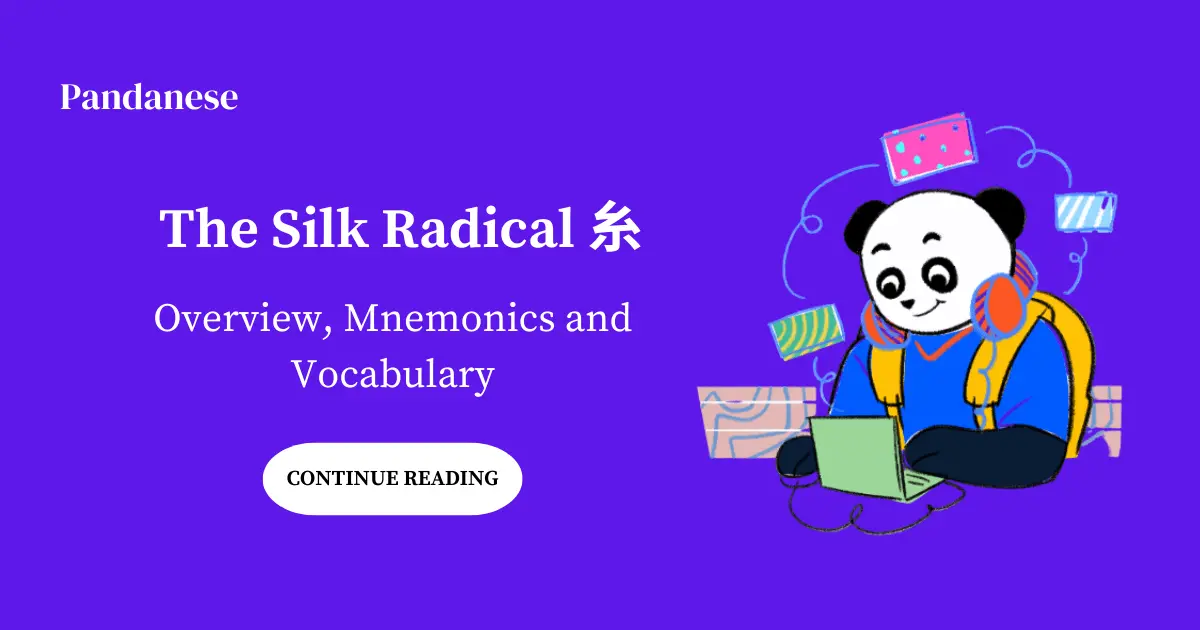
The Silk Radical 糸: Overview, Mnemonics, and Vocabulary
Have you ever seen a Chinese knot 中国结 zhōng guó jié? For those who are out of the loop, a Chinese knot is often made of silk cords. Speaking of which, today we’d like to share with you the radical for silk 糸 which appears in the phrase 中国结 zhōng guó jié.
Read on to learn about the silk radical, what it is, how to memorize it with fun mnemonics and a list of useful vocabulary (because the radical silk 糸 is one of the most popular characters).
What is the silk radical?
In Chinese, the silk radical is pronounced as “mì” and written as 糸. The radical silk 糸 is listed as radical 120 and is one of the 29 Kangxi radicals (214 radicals) composed of 6 strokes. The silk radical can be seen in characters that represent items with fine texture or are made from fine material. Also, according to the Kangxi dictionary, 823 characters (out of 49,030) contain the radical silk 糸.
This radical has different forms depending on if it’s used as an independent character or a character component. When used independently or as a bottom component, it’s written in its full form in both Traditional Chinese and Simplified Chinese (as in 索 suǒ “to demand,” 繁 fán “complicated”). However, when used as a left component, it is simplified as 糹in Traditional Chinese and 纟 in Simplified Chinese (as in 糾 jiū “to investigate,” 纪 jì “age,” 纹(紋) wén “line/mark”).
The radical silk 糸 was originally a pictogram describing a skein of silk. It also has been standardized and simplified many times over the years. Let’s have a look at the transformation of this radical silk.

Historical forms of the character 糸
What is the stroke order of the silk radical?
The silk radical has six strokes, written in the following order:

Silk Radical 糸 stroke order, Wikimedia Commons
How can you memorize the silk radical?
Though the radical silk 糸 evokes the image of a skein of silk which helps you memorize the character without much difficulty, there’s a learning technique that lets learners memorize this character with fun rather than learn it by heart—the mnemonics technique.
At Pandanese, we employ mnemonics flashcards to help Chinese learners like you get the most out of your learning. Your Chinese learning journey couldn’t get any easier! Or could it? Have a look at how mnemonics work in this example:

Pandanese silk radical mnemonic example.
Can you create mnemonics for yourself?
When it comes to using mnemonic devices to learn Chinese vocabulary, we recognize that a mnemonic may work well for one individual but not for another. In other words, everyone has their own individual logic behind their mnemonics. Let your voice be heard!
Therefore, we’ve created the “Synonym Feature” that allows you to make your own mnemonics. It’s often easier to memorize a character or radical by creating personalized mnemonics.

A silk radical vocabulary list for you!
Want to explore more about the silk radical and other related terms? Here’s a list of some of the essential words which contain the silk radical:
Character |
Pinyin |
English meaning |
丝 |
sī |
thread |
绳 |
shéng |
rope |
编 |
biān |
weave |
结 |
jié |
knot |
缝 |
fèng |
sew |
缝针 |
fèng zhēn |
needle |
给 |
gěi |
give |
红 |
hóng |
red |
维 |
wéi |
to hold together |
组 |
zǔ |
to form |
纸 |
zhǐ |
paper |
Silk radical vocabulary list
Could learning Chinese be a breeze?
Learning Chinese shouldn’t be hard—it should be easy and joyful! Ditch the Chinese textbook and rote learning method and instead try mnemonics; using mnemonics is proven to help learners digest new information more easily and efficiently.
Pandanese is a web-based application exclusively designed to help Chinese-language learners memorize Chinese characters easier and effectively. Pandanese uses scientifically proven memory-aid methods like mnemonics and Spaced Repetition System (SRS) to optimize your learning ability, helping you learn more than 6,000 hanzi and vocabulary within a year. Definitely give it a try!
The easiest way to learn Chinese & build vocabulary

